Traditional Vietnamese musical instruments
Traditional Vietnamese musical instruments are the musical instruments used in the traditional and classical musics of Vietnam. They comprise a wide range of string, wind, and percussion instruments, used by both the Viet (Kinh) majority as well as the nation's ethnic minorities.
Strings
Plucked
- Đàn bầu (also Đàn Bao) - monochord zither: often tuned C3, though tuning varies
- Đàn đáy - long-necked three-stringed lute with trapezoidal body: tuned G3 C4 F4
- Đàn nguyệt (also called nguyệt cầm or đàn kìm or Quân tử cầm) - moon-shaped two-string lute: no fixed tuning; strings are tuned a 4th, 5th, or 7th (minor)
- Đàn sến - two-string lute: tuning is variable
- Đàn tam - fretless lute with snakeskin-covered body and three strings: tuned F3 C4 F4
- Đàn tranh - long zither
- Đàn tỳ bà (also Đàn tyba) - pear-shaped lute with four strings" tuned C4 F4 G4 C5
- Đàn đoản (also called đàn tứ) - round- or square-shaped, flat-backed, 4-string lute with short neck, tuned C3 G3 D4 A4
- Guitar phím lõm (also called lục huyền cầm, ghi-ta phím lõm, or Đàn ghita) - "Vietnamized" acoustic or electric 5-string guitar with scalloped fretboard; used primarily in cải lương: tuned C3 F3 C4 G4 C5
- Đàn tứ dây - bass guitar in the shape of a đàn đáy
- Cầm - 7-stringed zither equivalent to the Chinese guqin; no longer used
- Sắt - zither with 25 strings equivalent to the Chinese se; no longer used
- Đàn tính - long-necked lute with a gourd body and two or three silk strings; used by the Tay, Nung, and Thai ethnic groups
- Bro - fretted zither with a body made of bamboo and a gourd resonator; used by minority ethnic groups in the Central Highlands
- Goong - tube zither with a bamboo body; used by minority ethnic groups in the Central Highlands
| Đàn Bầu | Đàn Đáy | Đàn Tranh | Đàn Tỳ bà | Đàn Tứ | Đàn Tính | Goong | |
|---|---|---|---|---|---|---|---|
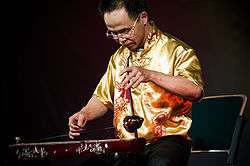 |
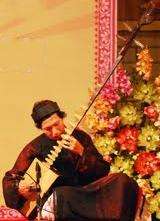 |
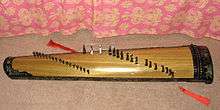 |
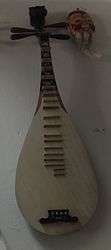 |
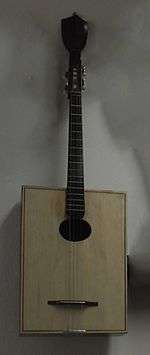 |
 |
||
Bowed
- Đàn gáo - two-stringed vertical violin with coconut resonator
- Đàn hồ - two-stringed vertical violin with wooden resonator; hồ derives from Chinese hu, as in huqin)
- Đàn nhị - two-stringed vertical violin
- K'ni (also spelled k'ny or k'ný) - one-string vertical violin; played by the Jarai people of the Central Highland
Struck
- Đàn tam thập lục - hammered dulcimer with 36 metal strings
Wind
Flutes
- Sáo (also called sáo trúc) - transverse flute made of bamboo or hardwood
Oboes
- Kèn - class of double reed instruments similar to the oboe and the Indian shehnai
- Kèn bầu - conical oboe with gourd-shaped wooden bell
- Kèn đám ma - conical oboe with metal bell; used for funeral music in northern Vietnam
Clarinets
- Bi doi - double clarinet similar to the Middle Eastern mijwiz; used in courtship context mainly within the Mường people.
Free reed mouth organs
- Đing nǎm (H'mong pen pipe) - free-reed mouth organ with gourd body and bamboo pipes; played by upland minorities
- M'buot - free-reed mouth organ with gourd body and bamboo pipes; played by upland minorities
Horns
- Púa - valveless brass trumpet
- Ốc "snail" - conch trumpet
- T'dep - Buffalo Horn
Percussion
Drums
- Trống - drum played with sticks
- Trống cái - bass drum
- Trống chầu or trống đế - the largest of the set of drums used in Hát tuồng.
- Trống cơm - rice drum
- Dong Son drum (also called trong dong Dong Son) - bronze drum played by the Dong Son culture in ancient times
- Nruas tuag (also called Ư chua - drum used by the Hmông ethnic group for funeral music
Tuned percussion
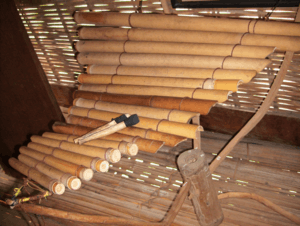
A t'rung of the E De people
- Biên khánh - a set of L-shaped flat stone chimes used in ancient court music;[1] derived from the Chinese bianqing
- Cồng chiêng - tuned gong (comes in both flat and knobbed varieties)
- Tam âm la - set of three small, high-pitched flat gongs in a frame; used primarily in nhã nhạc music
- T'rưng - bamboo xylophone
- Đàn đá - lithophone, commonly having 9+ stone bars, 65 cm-102 cm in length. It is believed the instrument dates back to 1000 BC. Also called Goong Lú (M’nong people), Kologolo (M’nong people), Gôông Luk (Mạ people).
Untuned percussion
Other
- Đàn môi - jaw harp
- Klông pút - set of bamboo tubes; hands are clapped near ends of tubes to produce musical tones
- Đàn tre "bamboo instrument" - A hybrid form of the Vietnamese plucked string instrument similar to a Đàn tính – called a Đàn tre – was created by Nguyễn Minh Tâm, who escaped from Vietnam in 1982 and ultimately settled in Australia. The instrument has twenty-three 800mm-long wire strings attached to a bamboo tube with a metal hose-clamp around the top rim. A four-litre, rectangular olive oil tin, which acts as a resonator, is clamped to the base of the tube. The instrument is capable of playing both Vietnamese and Western music. The instrument can be seen and recordings of it being played by its creator can be heard at the National Museum of Australia.[2]
- Kyey se - Vietnamese bell
See also
References
- ↑ Đại Dương (2010-12-09). "Sắp phục chế thành công 2 bộ nhạc cụ độc đáo đã thất truyền". Retrieved 2016-10-15.
- ↑ Jennifer Wilson (2008). Desley Deacon, Penny Russell, Angela Woollacott, eds. Transnational Ties: Australian Lives in the World. ANU E press. p. 289.
The dàn tre, translated simply as 'bamboo musical instrument', is the invention of Minh Tam Nguyen. Made from available materials first in Vietnam, then in the Philippines...
External links
| Wikimedia Commons has media related to Musical instruments of Vietnam. |
This article is issued from
Wikipedia.
The text is licensed under Creative Commons - Attribution - Sharealike.
Additional terms may apply for the media files.